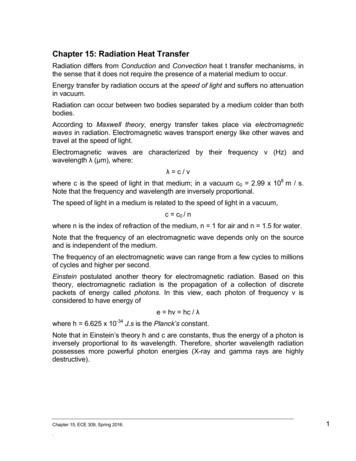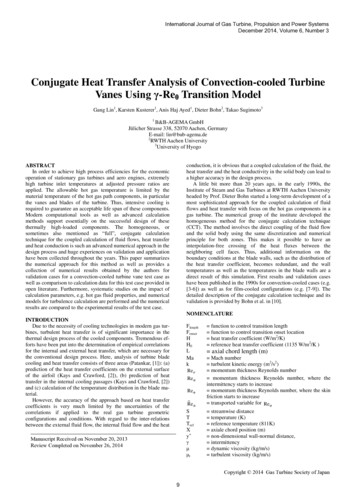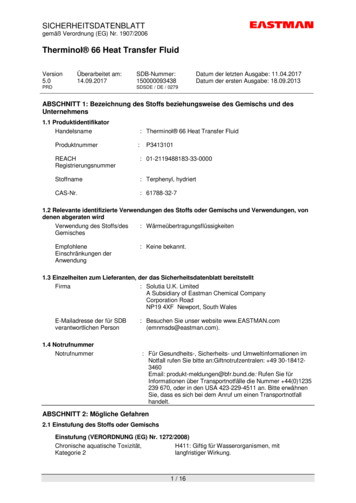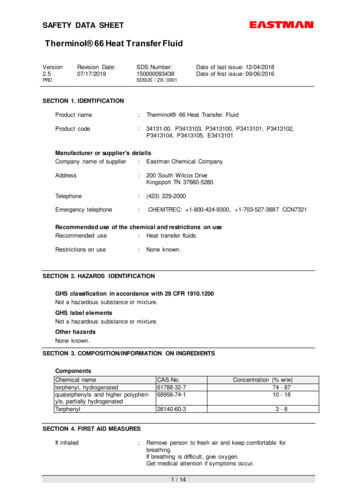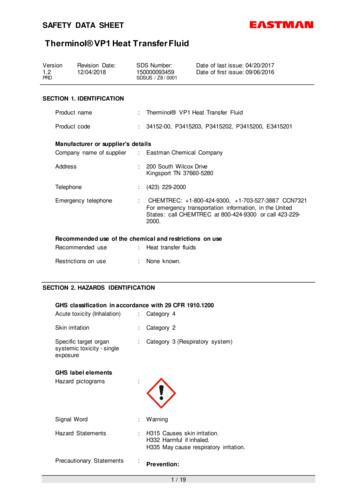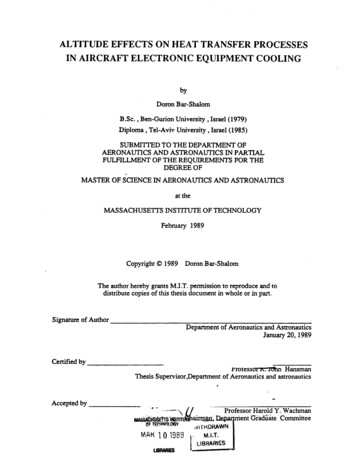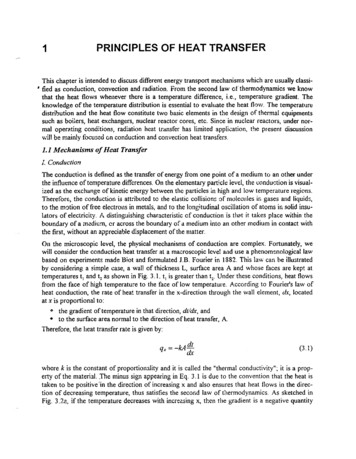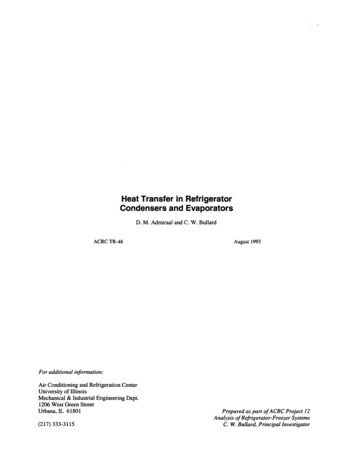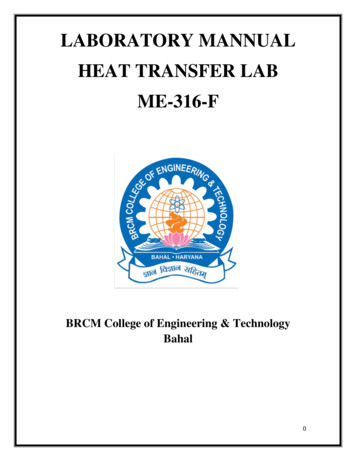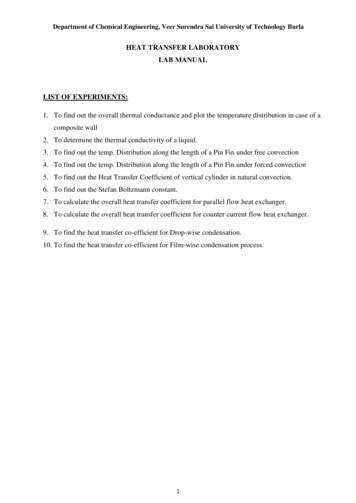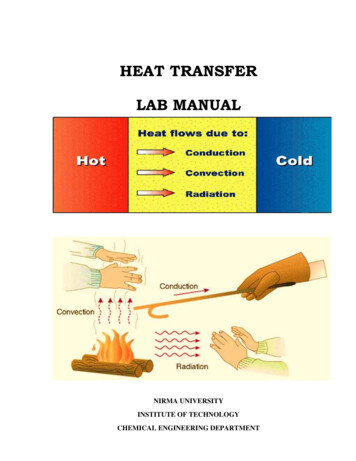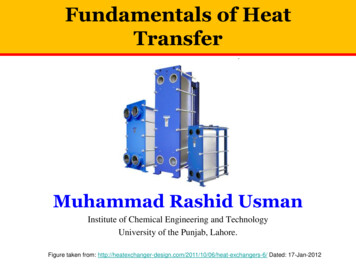
Transcription
Fundamentals of HeatTransferMuhammad Rashid UsmanInstitute of Chemical Engineering and TechnologyUniversity of the Punjab, Lahore.Figure taken from: changers-6/ Dated: 17-Jan-2012
Course contents mid termIntroduction to transfer processes. Definition, applications, and various units ofheat transfer. Modes of heat transfer: Conduction, convection, and radiation heattransfer. Fourier’s law of heat conduction. Thermal conductivity of gasses,liquids, and solids. Units of thermal conductivity. Effect of temperature, pressure,and composition on thermal conductivity of materials. Estimation of thermalconductivity of gases, liquids, and solids. Introduction to steady-state heattransfer. Heat conduction through plane wall, hollow cylinder, and hollowsphere. Numerical problems related to heat conduction through plane wall,hollow cylinder, and hollow sphere. Thermal resistances in series: Compositeplane wall, composite hollow cylinder, and composite hollow sphere. Numericalproblems related to heat conduction through composite plane wall, compositehollow cylinder, and composite hollow sphere. Free and forced convection. Rateequation for convective heat transfer coefficient. Brief description ofhydrodynamic boundary layer and heat transfer coefficient. Units of heat transfercoefficient. Individual and overall heat transfer coefficients: plane wall andhollow cylinder. Numerical problems regarding overall heat transfer coefficient.Determination of heat transfer coefficient. Description of various heat transfercorrelations. Heat transfer in coiled and jacketed agitated vessels.2
Thermal contact resistance [3]3
Thermal contact resistance [3]4
General heat conduction equationIt takes into account, unsteady-statecondition, all the three dimensions,and any heat generation within thematerial.5
Coordinate systems [3]6
General conductivity equation inrectangular coordinates [10]7
General conductivity equation inrectangular coordinates(Errors and omissions are expected)8
General conductivity equation inrectangular coordinates(Errors and omissions are expected)9
General conductivity equation inrectangular coordinates(Errors and omissions are expected)10
General conductivity equation inrectangular coordinates(Errors and omissions are expected)11
General conductivity equation inrectangular coordinates(Errors and omissions are expected)12
General conductivity equation inrectangular coordinates(Errors and omissions are expected)13
General conductivity equation in rectangularcoordinates (constant k, cp and ρ) Tk t c p 2T 2T 2T q 2 2 2 y z c p x 2T 2T 2T Tq 2 2 2 t y z c p xFor derivation see class notes.14
General conductivity equation in rectangularcoordinates (constant k, cp and ρ)In case no heat generation, we have the followingequation. This form of equation is called asFourier’s second law of heat conduction or heatdiffusion equation as the temperature variation area function only of thermal diffusivity. 2T 2T 2T T 2 2 2 t y z x15
General conductivity equation in rectangularcoordinates (constant k, cp and ρ)For steady-state condition, the general heatconduction equation can be written as thefollowing. This form of equation is called asPoisson’s equation for heat transfer. 2T 2T 2T q 2 2 2 k y z x16
General conductivity equation in rectangularcoordinates (constant k, cp and ρ)For steady-state condition and no heat generationsituation, the general heat conduction equation can bewritten as the following. This form of equation is calledas Laplace equation for heat transfer. 2T 2T 2T 2 2 2 0 y z xUsing the Laplacian operator, it may be shown that 2T 017
General conductivity equation inother coordinates [10](a) Cylindrical coordinates(b) Spherical coordinates18
General conductivity equation in othercoordinates (constant k, cp and ρ)In cylindrical coordinates: 2T 1 T 1 2T 2T Tq 2 2 2 2 tr r r z c p rIn spherical coordinates: 1 2 T T1 T 1 2T q 2 r 2 2 sin 22 t r sin c p r r r r sin 19
Homework problems20
Conduction with internal heatgeneration (Not for exams)Using general conductivity equation,derive an expression for internal heatgeneration in a plane wall with constantthermal conductivity where heat transferoccurs only in the x-direction.21
References1.Geankoplis, C.J. (2003). Transport processes and separation process principles: includesunit operations. 4th ed. Prentice-Hall International, Inc.2. Holman, J.P. (2010). Heat transfer. 10th ed. McGraw-Hill Higher Education, Singapore.3. Cengel, Y.A. (2003). Heat transfer: A practical approach. 2nd ed. McGraw-Hill.4. Incropera, F.P.; DeWitt, D.P.; Bergman, T.L.; Lavine. A.S. (2007) Fundamentals of heatand mass transfer. 6th ed. John Wiley & Sons, Inc.5. Kern, D.Q. (1965). Process heat transfer. McGraw-Hill International Book Co., Singapore.6. McCabe, W.L.; Smith, J.C.; Harriott, P. (1993). Unit operations of chemical engineering.5th ed. McGraw-Hill, Inc., Singapore.7. Coulson, J.M.; Richardson, J.F.; Backhurst, J.R.; Harker, J.H. (1999). Coulson andRichardson’s Chemical engineering: Fluid flow, heat transfer and mass transfer. vol. 1. 6thed. Butterwoth-Heinemann, Oxford.8. Staff of Research and Education Association. (1984). The heat transfer problem solver.Research and Education Association, New Jersey.9. Kreith, F.; Manglik, R.M.; Bohn, M.S. (2011). Principles of heat transfer, 7th ed., Cengagelearning.10. Mills A.F. (1995). Heat and mass transfer. Richard D. Irwin, Inc.22
Heat transfer in coiled and jacketed agitated vessels. 3 Thermal contact resistance [3] 4 Thermal contact resistance [3] 5 General heat conduction equation It takes into account, unsteady-state condition, all the three dimensions, and any heat generation within the material. 6 Coordinate systems [3] 7 General conductivity equation in rectangular coordinates [10] 8 General conductivity equation .

